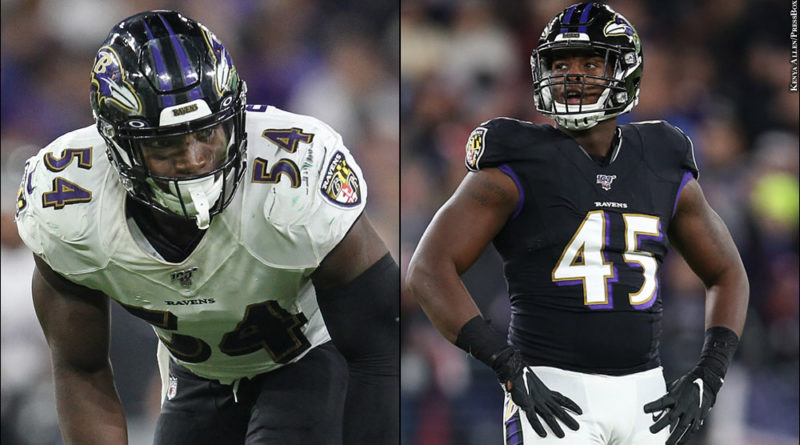I think the Ravens had a pretty good NFL Draft.
I’ve learned enough to know that there is absolutely nothing worthwhile about attempting to judge the performance of a team in the draft. Please remember how few analysts raved about the team selecting Jonathan Ogden and Ray Lewis in the first round in 1996 while (and not to dunk on the man while he’s battling COVID-19, I truly hope he is feeling better), ESPN’s Todd McShay absurdly claimed the team’s 2016 draft may have produced the single greatest round of all time in the fourth round.
The five players they selected in that round have combined to offer … just slightly more than nothing. Cornerback Tavon Young has battled injuries and may still prove to be a solid player while wide receiver Chris Moore is the only other member of the group that even remains on the team. (The other third-round draft picks were offensive lineman Alex Lewis, running back Kenneth Dixon and defensive tackle Willie Henry.)
I’m in the midst of reading Keith Law’s new book “The Inside Game,” which is all about biases and how biases impact baseball in particular. It reminds me that despite instant draft analysis being an utterly worthless exercise, the content factory market demands we do it. There is no type of analysis where bias is more on display that post-draft analysis.
An analyst named Jon Ledyard thinks the Ravens hit it out of the park when they selected Michigan guard Ben Bredeson with the 143rd pick … because in his mind, Bredeson was the 65th player on his board. He is of course biased toward his own scouting analysis, suggesting Baltimore got a steal. It is of course equally if not more probable that his scouting might have simply been way off base. (For the record, I too think Bredeson was a good pick at that point but I have absolutely zero idea if he was anything more than the 143rd-best player in the draft.)
But draft analysis bias isn’t based on self-scouting anchoring issues alone. Confirmation bias tends to rear its ugly head a fair bit as well. While many analysts (Mel Kiper Jr. chief among them) gave the Ravens high praise for this draft, most of those analysts ALWAYS tend to praise the Ravens’ drafting ability (and front office in general), and rightfully so, of course. The Ravens have historically drafted well, so when they do seem to “reach” for a player — like most analysts seemed to think they did with offensive tackle Tyre Phillips — we’re more inclined to give them the benefit of the doubt.
NONE of this means the Ravens didn’t have a great draft. It means we have absolutely no idea if they did and won’t for some time.
I personally liked a lot of what the Ravens did during the weekend (acknowledging my biases). I think Patrick Queen is a very solid player, and I don’t think the 28th pick is necessarily too early to take an inside linebacker. I honestly kinda loved their selection of J.K. Dobbins in the second round because football sources I’ve spoken to have genuinely sold me on the idea that “if all positions were equal” (i.e. if we hadn’t devalued running back to the point where we almost refuse to draft them), he would genuinely be one of the 20-25 best players in the draft.
I believe they got some value in the later rounds as well. I would have definitely preferred some more high-end wide receiver talent (I was prepared to go streaking right up until the moment where the Jets took Denzel Mims one damn pick before they were on the board at 60), but I think they had a pretty good weekend!
My biggest takeaway post-draft isn’t really about what they did during the course of the weekend though. And it’s not quite as cheery, unfortunately.
I don’t think the Ravens should have necessarily forced the issue at edge rush at any point during the draft and dramatically reached to fill the need. But we cannot pretend like this isn’t a major issue, either.
It is reasonable to assume that if there is anything even remotely similar to a “normal” football season, Matthew Judon is likely to eventually sign his franchise tag and report to the team. But what does that look like, exactly? Will he participate in a training camp? Will he extend a holdout into the season in an attempt to gain as much leverage as humanly possible in a system players clearly believe is irreparably broken? There’s no reason to assume any of these things, but those question marks (and the team’s long-term uneasiness about the player) are certainly concerns.
Perhaps Jaylon Ferguson is prepared to step up this season and help be a solution. Perhaps there’s still something to be seen from Tyus Bowser. Perhaps the defensive line is built to make more of a pass rush impact. Perhaps Wink Martindale’s “bring pressure from everywhere” scheming will again mean the burden is less on the edge rushers specifically. Perhaps analytically the team will prove that the combination of pressure and a strong, deep secondary will overcome any shortcomings in the edge rush department.
But until we see that, I can’t help but think the edge rush thing is both the biggest short-term and long-term issue the roster faces. (For the record, I’m also still a little concerned about whether they’d be capable offensively of winning a slugfest against a team like the Chiefs if they have to throw the ball 50-plus times but they clearly want to avoid even that hypothetical possibility altogether.)
Oh, and I guess there’s still the “will there even be a short term?” issue. I’m hoping that won’t prove to be an issue at all. But again, I’m biased.
Photo Credit: Kenya Allen/PressBox

